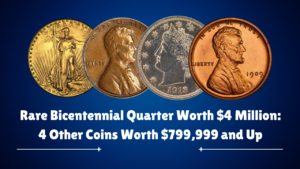Coin collecting has always been a fascinating hobby, but did you know that a simple Bicentennial Quarter could turn your life around financially? Released in 1976 to celebrate the 200th anniversary of the United States, these quarters feature a unique dual date “1776-1976” and a special reverse design. While most Bicentennial Quarters are common, a select few have become highly sought after by collectors and could be worth as much as $100,000.
Why Are Bicentennial Quarters Valuable?

The value of a Bicentennial Quarter depends on several factors, including rarity, condition, and unique characteristics such as minting errors or proof quality. Here’s what makes these coins stand out:
- Minting Errors
Coins with errors, such as doubled dies or missing mint marks, are highly prized. These errors occur during the production process, making them unique. - Silver Composition
While most Bicentennial Quarters are made of copper-nickel, some were struck in 40% silver for special collector’s sets. These silver quarters are significantly more valuable. - High-Grade Condition
Quarters in mint condition, especially those graded MS67 or higher by professional grading services, can fetch thousands of dollars. - Low Mintage Variants
Certain Bicentennial Quarters produced at the San Francisco Mint (marked with an “S”) in limited quantities are rarer and thus more valuable.
Key Features to Look For
- Double Die Obverse or Reverse
Look for doubling in the text or images on the coin. - Missing Mint Mark
Coins without the typical “D” (Denver) or “P” (Philadelphia) mint marks could be rare errors. - Silver Composition
These can be identified by their brighter luster and weight.
How to Identify and Sell Your Rare Quarters

- Examine Your Coins
Use a magnifying glass to inspect your Bicentennial Quarters for any signs of errors or special characteristics. - Get Your Coins Graded
Submit your coins to a professional grading service like PCGS or NGC to determine their value and authenticity. - Auction or Private Sale
Rare coins can be sold at auctions, through coin dealers, or directly to collectors. Online platforms like eBay and specialized coin marketplaces are great places to start.
Conclusion
Rare Bicentennial Quarters are more than just pieces of history; they could be your ticket to financial freedom. By understanding what makes these coins valuable and knowing how to identify them, you could uncover a hidden treasure right in your pocket change. So, dig through your collection or start checking your spare change—you might just strike gold with a $100,000 coin.
FAQs
1. How do I know if my Bicentennial Quarter is rare?
Look for minting errors, missing mint marks, or silver composition. High-grade coins and limited mintage variants also have higher value.
2. What is the most valuable Bicentennial Quarter ever sold?
A top-grade MS68 Bicentennial Quarter once sold for over $100,000 at auction.
3. Where can I sell my rare Bicentennial Quarter?
You can sell to coin dealers, through auctions, or even on-line on eBay or Heritage Auctions.
4. Are all Bicentennial Quarters valuable?
No only some, the ones with special attributes or those that are graded in mint condition have value
5. How much does it cost to get a coin graded?
It varies based on the service or the grade and the worth of the coin, but the range from $20 to $100.



